Customs and Trade Facilitation: Improving Global Trade Efficiency
VerifiedAdded on 2023/04/11
|7
|1348
|322
Report
AI Summary
This report provides a comprehensive overview of the role of customs in trade facilitation, emphasizing the importance of streamlining processes, reducing transaction costs, and enhancing the security of goods in international trade. It highlights the necessity of customs and governmental agencies working collaboratively to enforce regulations related to imports, exports, and passenger services. Drawing from the work of Uzzaman and Yusuf, the report addresses challenges such as corruption, delays, and inadequate infrastructure, advocating for the adoption of international standards like the Revised Kyoto Convention (RKC) to promote transparency, predictability, and the use of technology. The report concludes by recommending the implementation of Trade Facilitation Indicators (TFIs) and the leveraging of technology to automate tasks and improve efficiency, ultimately contributing to a country's economic growth through effective trade facilitation.
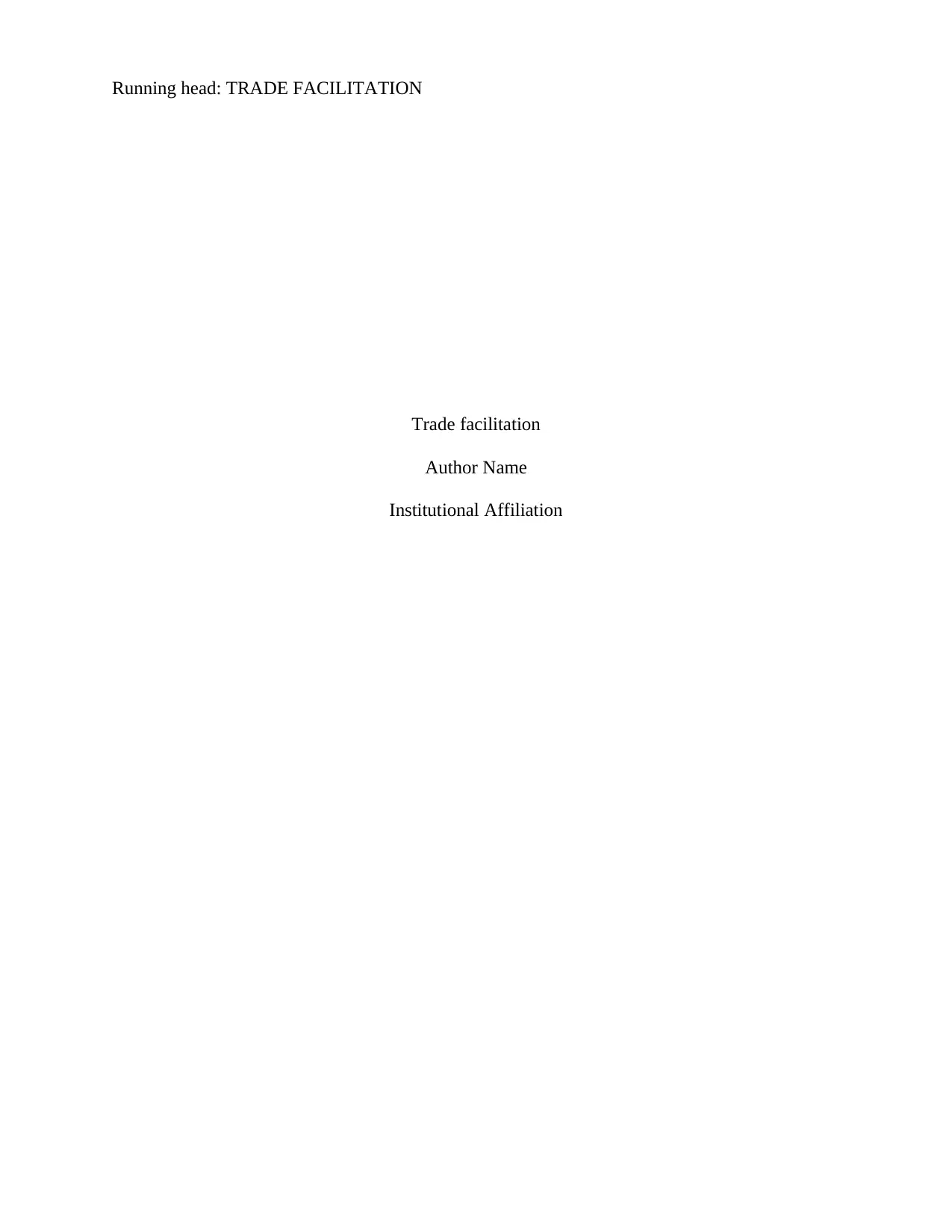
Running head: TRADE FACILITATION
Trade facilitation
Author Name
Institutional Affiliation
Trade facilitation
Author Name
Institutional Affiliation
Paraphrase This Document
Need a fresh take? Get an instant paraphrase of this document with our AI Paraphraser
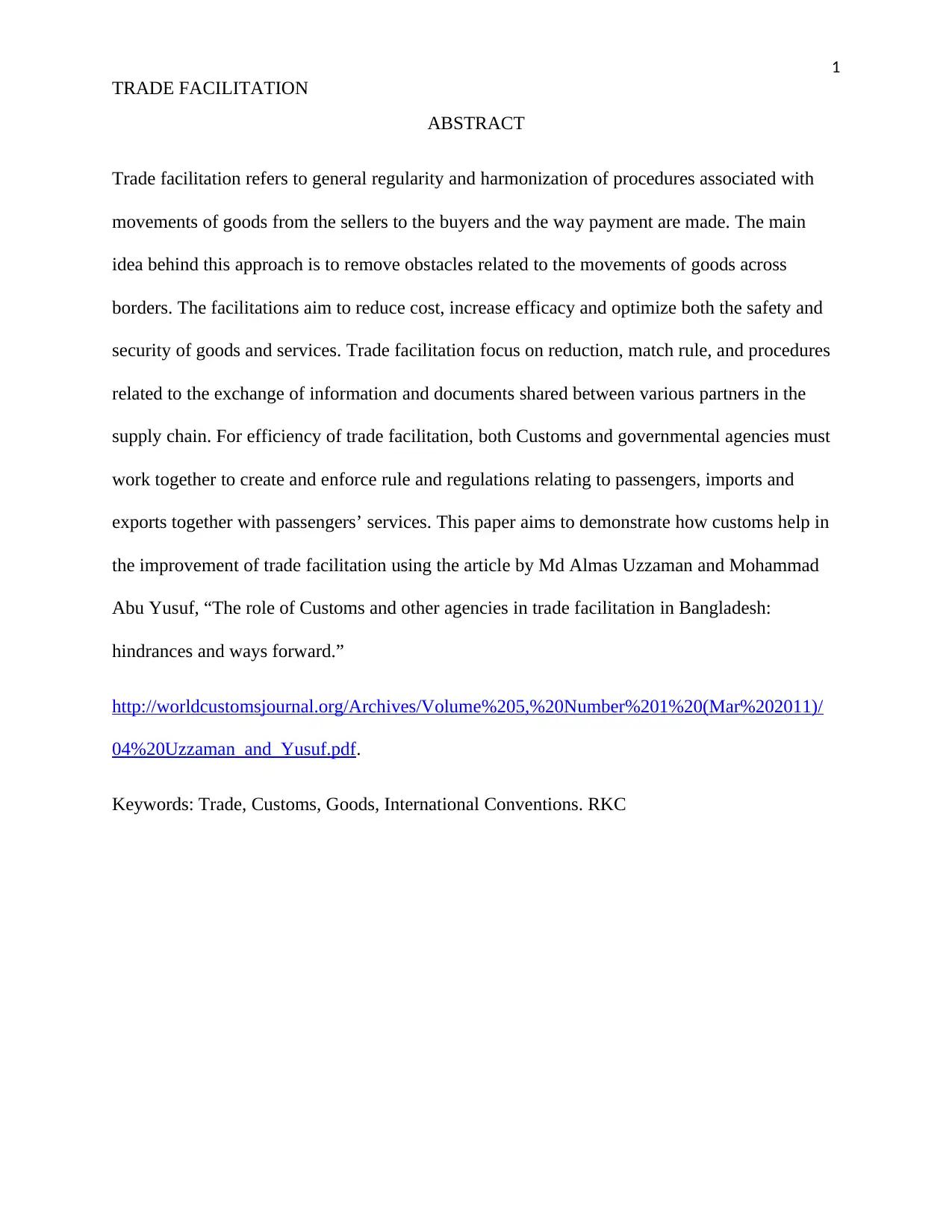
1
TRADE FACILITATION
ABSTRACT
Trade facilitation refers to general regularity and harmonization of procedures associated with
movements of goods from the sellers to the buyers and the way payment are made. The main
idea behind this approach is to remove obstacles related to the movements of goods across
borders. The facilitations aim to reduce cost, increase efficacy and optimize both the safety and
security of goods and services. Trade facilitation focus on reduction, match rule, and procedures
related to the exchange of information and documents shared between various partners in the
supply chain. For efficiency of trade facilitation, both Customs and governmental agencies must
work together to create and enforce rule and regulations relating to passengers, imports and
exports together with passengers’ services. This paper aims to demonstrate how customs help in
the improvement of trade facilitation using the article by Md Almas Uzzaman and Mohammad
Abu Yusuf, “The role of Customs and other agencies in trade facilitation in Bangladesh:
hindrances and ways forward.”
http://worldcustomsjournal.org/Archives/Volume%205,%20Number%201%20(Mar%202011)/
04%20Uzzaman_and_Yusuf.pdf.
Keywords: Trade, Customs, Goods, International Conventions. RKC
TRADE FACILITATION
ABSTRACT
Trade facilitation refers to general regularity and harmonization of procedures associated with
movements of goods from the sellers to the buyers and the way payment are made. The main
idea behind this approach is to remove obstacles related to the movements of goods across
borders. The facilitations aim to reduce cost, increase efficacy and optimize both the safety and
security of goods and services. Trade facilitation focus on reduction, match rule, and procedures
related to the exchange of information and documents shared between various partners in the
supply chain. For efficiency of trade facilitation, both Customs and governmental agencies must
work together to create and enforce rule and regulations relating to passengers, imports and
exports together with passengers’ services. This paper aims to demonstrate how customs help in
the improvement of trade facilitation using the article by Md Almas Uzzaman and Mohammad
Abu Yusuf, “The role of Customs and other agencies in trade facilitation in Bangladesh:
hindrances and ways forward.”
http://worldcustomsjournal.org/Archives/Volume%205,%20Number%201%20(Mar%202011)/
04%20Uzzaman_and_Yusuf.pdf.
Keywords: Trade, Customs, Goods, International Conventions. RKC
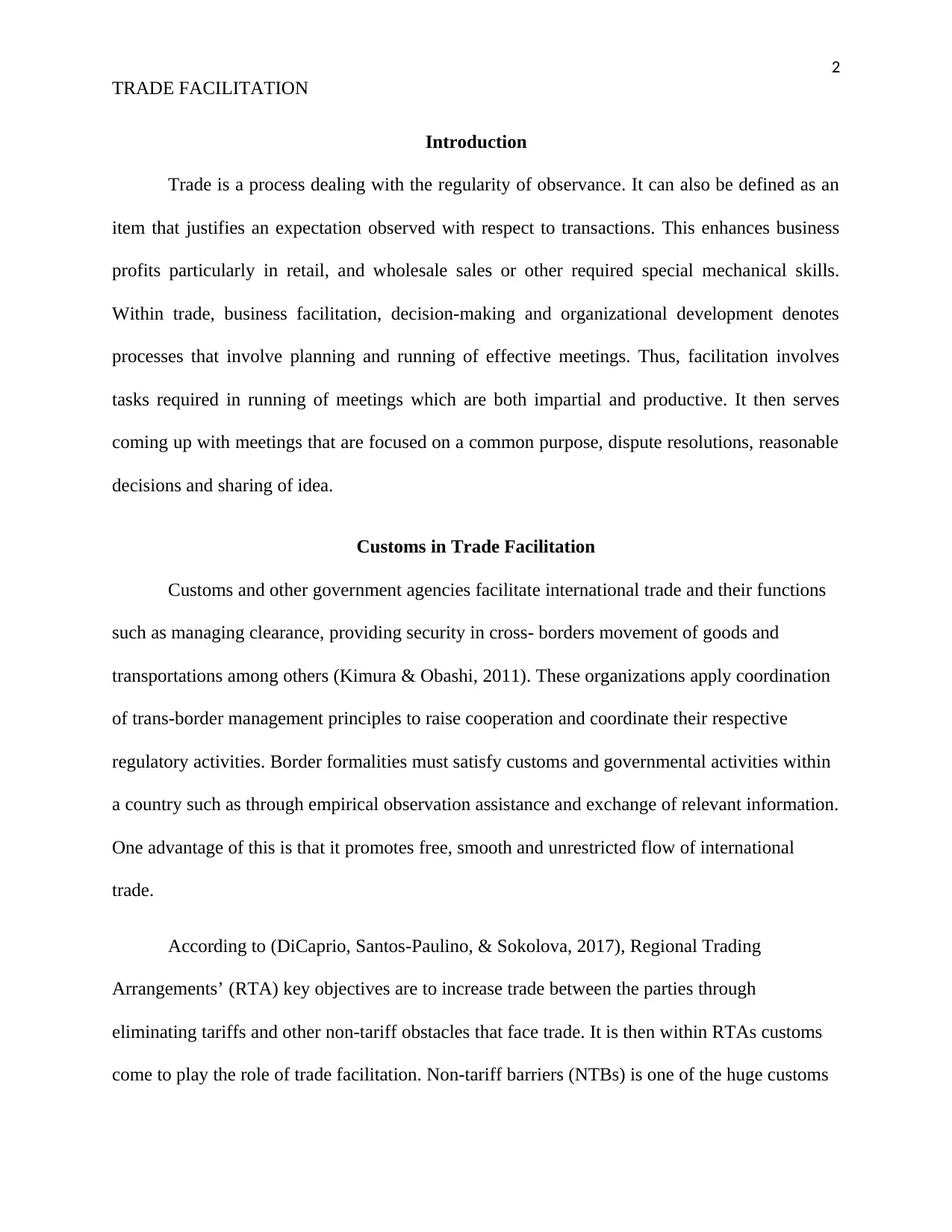
2
TRADE FACILITATION
Introduction
Trade is a process dealing with the regularity of observance. It can also be defined as an
item that justifies an expectation observed with respect to transactions. This enhances business
profits particularly in retail, and wholesale sales or other required special mechanical skills.
Within trade, business facilitation, decision-making and organizational development denotes
processes that involve planning and running of effective meetings. Thus, facilitation involves
tasks required in running of meetings which are both impartial and productive. It then serves
coming up with meetings that are focused on a common purpose, dispute resolutions, reasonable
decisions and sharing of idea.
Customs in Trade Facilitation
Customs and other government agencies facilitate international trade and their functions
such as managing clearance, providing security in cross- borders movement of goods and
transportations among others (Kimura & Obashi, 2011). These organizations apply coordination
of trans-border management principles to raise cooperation and coordinate their respective
regulatory activities. Border formalities must satisfy customs and governmental activities within
a country such as through empirical observation assistance and exchange of relevant information.
One advantage of this is that it promotes free, smooth and unrestricted flow of international
trade.
According to (DiCaprio, Santos-Paulino, & Sokolova, 2017), Regional Trading
Arrangements’ (RTA) key objectives are to increase trade between the parties through
eliminating tariffs and other non-tariff obstacles that face trade. It is then within RTAs customs
come to play the role of trade facilitation. Non-tariff barriers (NTBs) is one of the huge customs
TRADE FACILITATION
Introduction
Trade is a process dealing with the regularity of observance. It can also be defined as an
item that justifies an expectation observed with respect to transactions. This enhances business
profits particularly in retail, and wholesale sales or other required special mechanical skills.
Within trade, business facilitation, decision-making and organizational development denotes
processes that involve planning and running of effective meetings. Thus, facilitation involves
tasks required in running of meetings which are both impartial and productive. It then serves
coming up with meetings that are focused on a common purpose, dispute resolutions, reasonable
decisions and sharing of idea.
Customs in Trade Facilitation
Customs and other government agencies facilitate international trade and their functions
such as managing clearance, providing security in cross- borders movement of goods and
transportations among others (Kimura & Obashi, 2011). These organizations apply coordination
of trans-border management principles to raise cooperation and coordinate their respective
regulatory activities. Border formalities must satisfy customs and governmental activities within
a country such as through empirical observation assistance and exchange of relevant information.
One advantage of this is that it promotes free, smooth and unrestricted flow of international
trade.
According to (DiCaprio, Santos-Paulino, & Sokolova, 2017), Regional Trading
Arrangements’ (RTA) key objectives are to increase trade between the parties through
eliminating tariffs and other non-tariff obstacles that face trade. It is then within RTAs customs
come to play the role of trade facilitation. Non-tariff barriers (NTBs) is one of the huge customs
⊘ This is a preview!⊘
Do you want full access?
Subscribe today to unlock all pages.

Trusted by 1+ million students worldwide
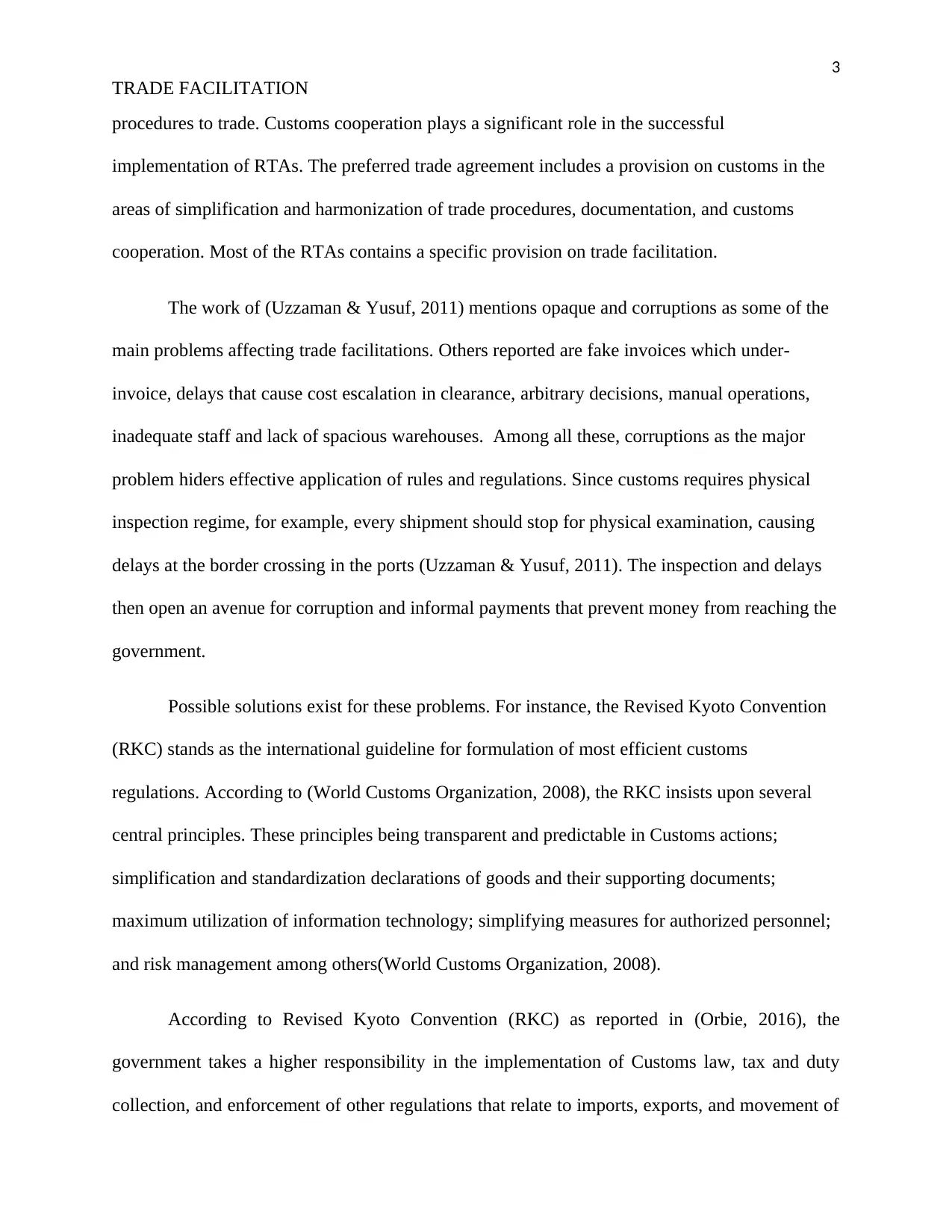
3
TRADE FACILITATION
procedures to trade. Customs cooperation plays a significant role in the successful
implementation of RTAs. The preferred trade agreement includes a provision on customs in the
areas of simplification and harmonization of trade procedures, documentation, and customs
cooperation. Most of the RTAs contains a specific provision on trade facilitation.
The work of (Uzzaman & Yusuf, 2011) mentions opaque and corruptions as some of the
main problems affecting trade facilitations. Others reported are fake invoices which under-
invoice, delays that cause cost escalation in clearance, arbitrary decisions, manual operations,
inadequate staff and lack of spacious warehouses. Among all these, corruptions as the major
problem hiders effective application of rules and regulations. Since customs requires physical
inspection regime, for example, every shipment should stop for physical examination, causing
delays at the border crossing in the ports (Uzzaman & Yusuf, 2011). The inspection and delays
then open an avenue for corruption and informal payments that prevent money from reaching the
government.
Possible solutions exist for these problems. For instance, the Revised Kyoto Convention
(RKC) stands as the international guideline for formulation of most efficient customs
regulations. According to (World Customs Organization, 2008), the RKC insists upon several
central principles. These principles being transparent and predictable in Customs actions;
simplification and standardization declarations of goods and their supporting documents;
maximum utilization of information technology; simplifying measures for authorized personnel;
and risk management among others(World Customs Organization, 2008).
According to Revised Kyoto Convention (RKC) as reported in (Orbie, 2016), the
government takes a higher responsibility in the implementation of Customs law, tax and duty
collection, and enforcement of other regulations that relate to imports, exports, and movement of
TRADE FACILITATION
procedures to trade. Customs cooperation plays a significant role in the successful
implementation of RTAs. The preferred trade agreement includes a provision on customs in the
areas of simplification and harmonization of trade procedures, documentation, and customs
cooperation. Most of the RTAs contains a specific provision on trade facilitation.
The work of (Uzzaman & Yusuf, 2011) mentions opaque and corruptions as some of the
main problems affecting trade facilitations. Others reported are fake invoices which under-
invoice, delays that cause cost escalation in clearance, arbitrary decisions, manual operations,
inadequate staff and lack of spacious warehouses. Among all these, corruptions as the major
problem hiders effective application of rules and regulations. Since customs requires physical
inspection regime, for example, every shipment should stop for physical examination, causing
delays at the border crossing in the ports (Uzzaman & Yusuf, 2011). The inspection and delays
then open an avenue for corruption and informal payments that prevent money from reaching the
government.
Possible solutions exist for these problems. For instance, the Revised Kyoto Convention
(RKC) stands as the international guideline for formulation of most efficient customs
regulations. According to (World Customs Organization, 2008), the RKC insists upon several
central principles. These principles being transparent and predictable in Customs actions;
simplification and standardization declarations of goods and their supporting documents;
maximum utilization of information technology; simplifying measures for authorized personnel;
and risk management among others(World Customs Organization, 2008).
According to Revised Kyoto Convention (RKC) as reported in (Orbie, 2016), the
government takes a higher responsibility in the implementation of Customs law, tax and duty
collection, and enforcement of other regulations that relate to imports, exports, and movement of
Paraphrase This Document
Need a fresh take? Get an instant paraphrase of this document with our AI Paraphraser
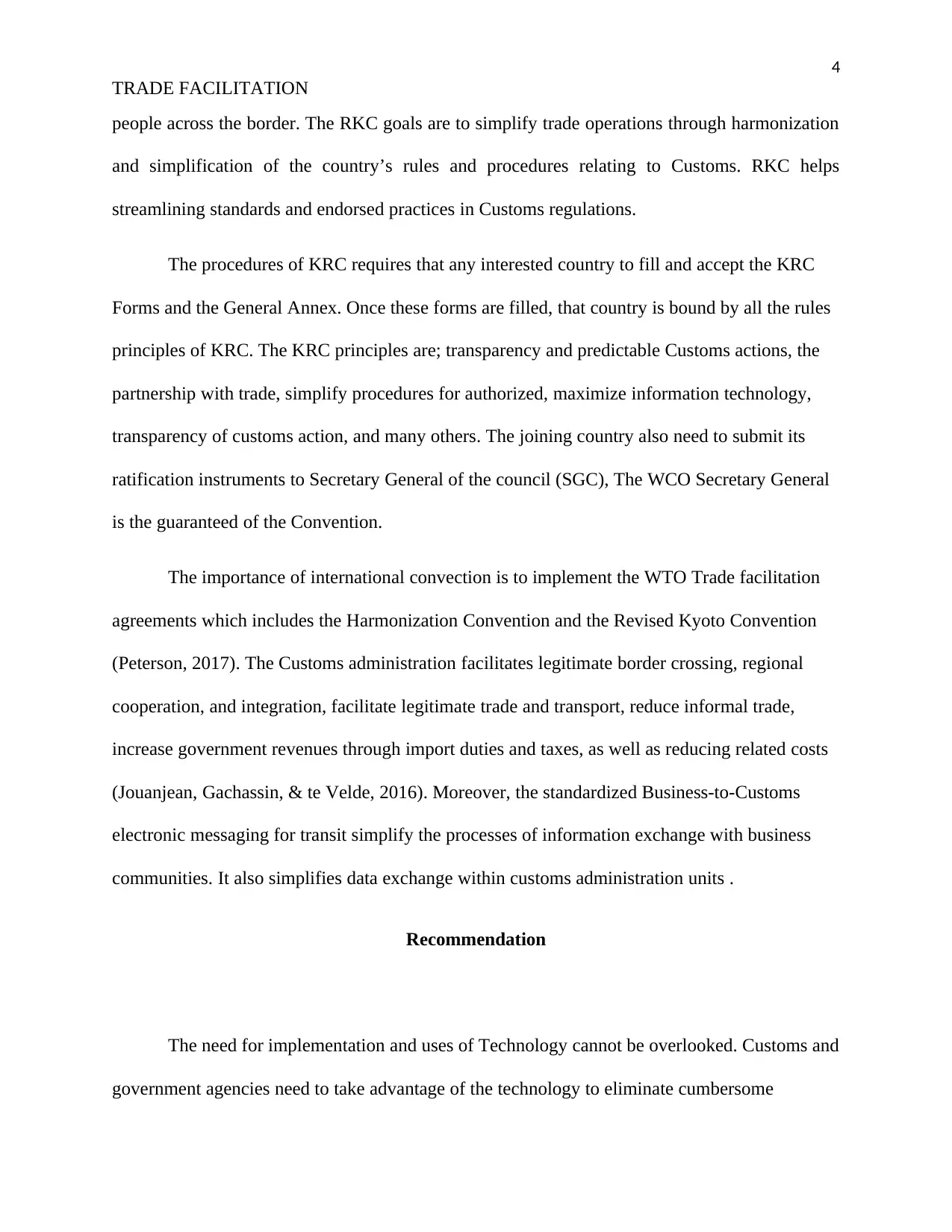
4
TRADE FACILITATION
people across the border. The RKC goals are to simplify trade operations through harmonization
and simplification of the country’s rules and procedures relating to Customs. RKC helps
streamlining standards and endorsed practices in Customs regulations.
The procedures of KRC requires that any interested country to fill and accept the KRC
Forms and the General Annex. Once these forms are filled, that country is bound by all the rules
principles of KRC. The KRC principles are; transparency and predictable Customs actions, the
partnership with trade, simplify procedures for authorized, maximize information technology,
transparency of customs action, and many others. The joining country also need to submit its
ratification instruments to Secretary General of the council (SGC), The WCO Secretary General
is the guaranteed of the Convention.
The importance of international convection is to implement the WTO Trade facilitation
agreements which includes the Harmonization Convention and the Revised Kyoto Convention
(Peterson, 2017). The Customs administration facilitates legitimate border crossing, regional
cooperation, and integration, facilitate legitimate trade and transport, reduce informal trade,
increase government revenues through import duties and taxes, as well as reducing related costs
(Jouanjean, Gachassin, & te Velde, 2016). Moreover, the standardized Business-to-Customs
electronic messaging for transit simplify the processes of information exchange with business
communities. It also simplifies data exchange within customs administration units .
Recommendation
The need for implementation and uses of Technology cannot be overlooked. Customs and
government agencies need to take advantage of the technology to eliminate cumbersome
TRADE FACILITATION
people across the border. The RKC goals are to simplify trade operations through harmonization
and simplification of the country’s rules and procedures relating to Customs. RKC helps
streamlining standards and endorsed practices in Customs regulations.
The procedures of KRC requires that any interested country to fill and accept the KRC
Forms and the General Annex. Once these forms are filled, that country is bound by all the rules
principles of KRC. The KRC principles are; transparency and predictable Customs actions, the
partnership with trade, simplify procedures for authorized, maximize information technology,
transparency of customs action, and many others. The joining country also need to submit its
ratification instruments to Secretary General of the council (SGC), The WCO Secretary General
is the guaranteed of the Convention.
The importance of international convection is to implement the WTO Trade facilitation
agreements which includes the Harmonization Convention and the Revised Kyoto Convention
(Peterson, 2017). The Customs administration facilitates legitimate border crossing, regional
cooperation, and integration, facilitate legitimate trade and transport, reduce informal trade,
increase government revenues through import duties and taxes, as well as reducing related costs
(Jouanjean, Gachassin, & te Velde, 2016). Moreover, the standardized Business-to-Customs
electronic messaging for transit simplify the processes of information exchange with business
communities. It also simplifies data exchange within customs administration units .
Recommendation
The need for implementation and uses of Technology cannot be overlooked. Customs and
government agencies need to take advantage of the technology to eliminate cumbersome
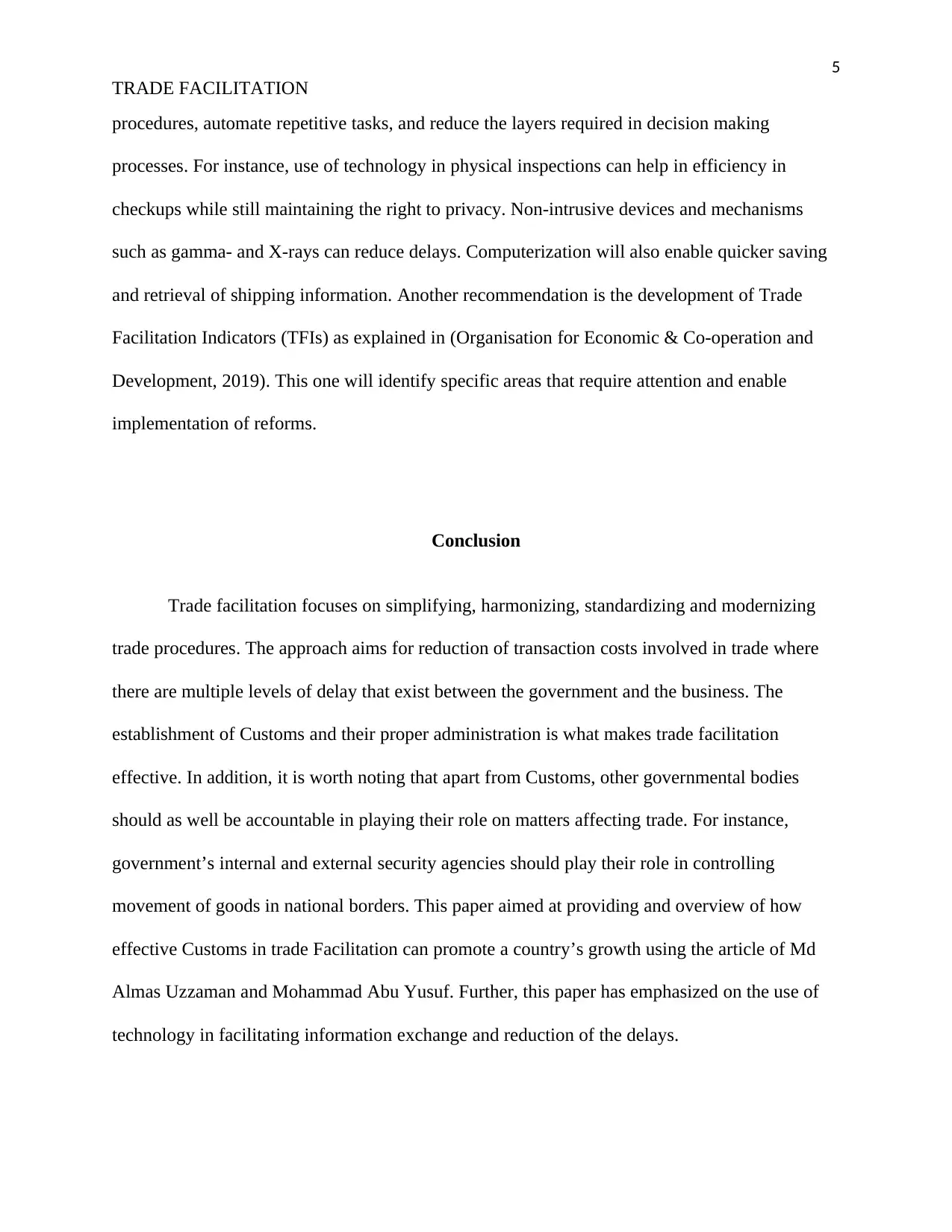
5
TRADE FACILITATION
procedures, automate repetitive tasks, and reduce the layers required in decision making
processes. For instance, use of technology in physical inspections can help in efficiency in
checkups while still maintaining the right to privacy. Non-intrusive devices and mechanisms
such as gamma- and X-rays can reduce delays. Computerization will also enable quicker saving
and retrieval of shipping information. Another recommendation is the development of Trade
Facilitation Indicators (TFIs) as explained in (Organisation for Economic & Co-operation and
Development, 2019). This one will identify specific areas that require attention and enable
implementation of reforms.
Conclusion
Trade facilitation focuses on simplifying, harmonizing, standardizing and modernizing
trade procedures. The approach aims for reduction of transaction costs involved in trade where
there are multiple levels of delay that exist between the government and the business. The
establishment of Customs and their proper administration is what makes trade facilitation
effective. In addition, it is worth noting that apart from Customs, other governmental bodies
should as well be accountable in playing their role on matters affecting trade. For instance,
government’s internal and external security agencies should play their role in controlling
movement of goods in national borders. This paper aimed at providing and overview of how
effective Customs in trade Facilitation can promote a country’s growth using the article of Md
Almas Uzzaman and Mohammad Abu Yusuf. Further, this paper has emphasized on the use of
technology in facilitating information exchange and reduction of the delays.
TRADE FACILITATION
procedures, automate repetitive tasks, and reduce the layers required in decision making
processes. For instance, use of technology in physical inspections can help in efficiency in
checkups while still maintaining the right to privacy. Non-intrusive devices and mechanisms
such as gamma- and X-rays can reduce delays. Computerization will also enable quicker saving
and retrieval of shipping information. Another recommendation is the development of Trade
Facilitation Indicators (TFIs) as explained in (Organisation for Economic & Co-operation and
Development, 2019). This one will identify specific areas that require attention and enable
implementation of reforms.
Conclusion
Trade facilitation focuses on simplifying, harmonizing, standardizing and modernizing
trade procedures. The approach aims for reduction of transaction costs involved in trade where
there are multiple levels of delay that exist between the government and the business. The
establishment of Customs and their proper administration is what makes trade facilitation
effective. In addition, it is worth noting that apart from Customs, other governmental bodies
should as well be accountable in playing their role on matters affecting trade. For instance,
government’s internal and external security agencies should play their role in controlling
movement of goods in national borders. This paper aimed at providing and overview of how
effective Customs in trade Facilitation can promote a country’s growth using the article of Md
Almas Uzzaman and Mohammad Abu Yusuf. Further, this paper has emphasized on the use of
technology in facilitating information exchange and reduction of the delays.
⊘ This is a preview!⊘
Do you want full access?
Subscribe today to unlock all pages.

Trusted by 1+ million students worldwide
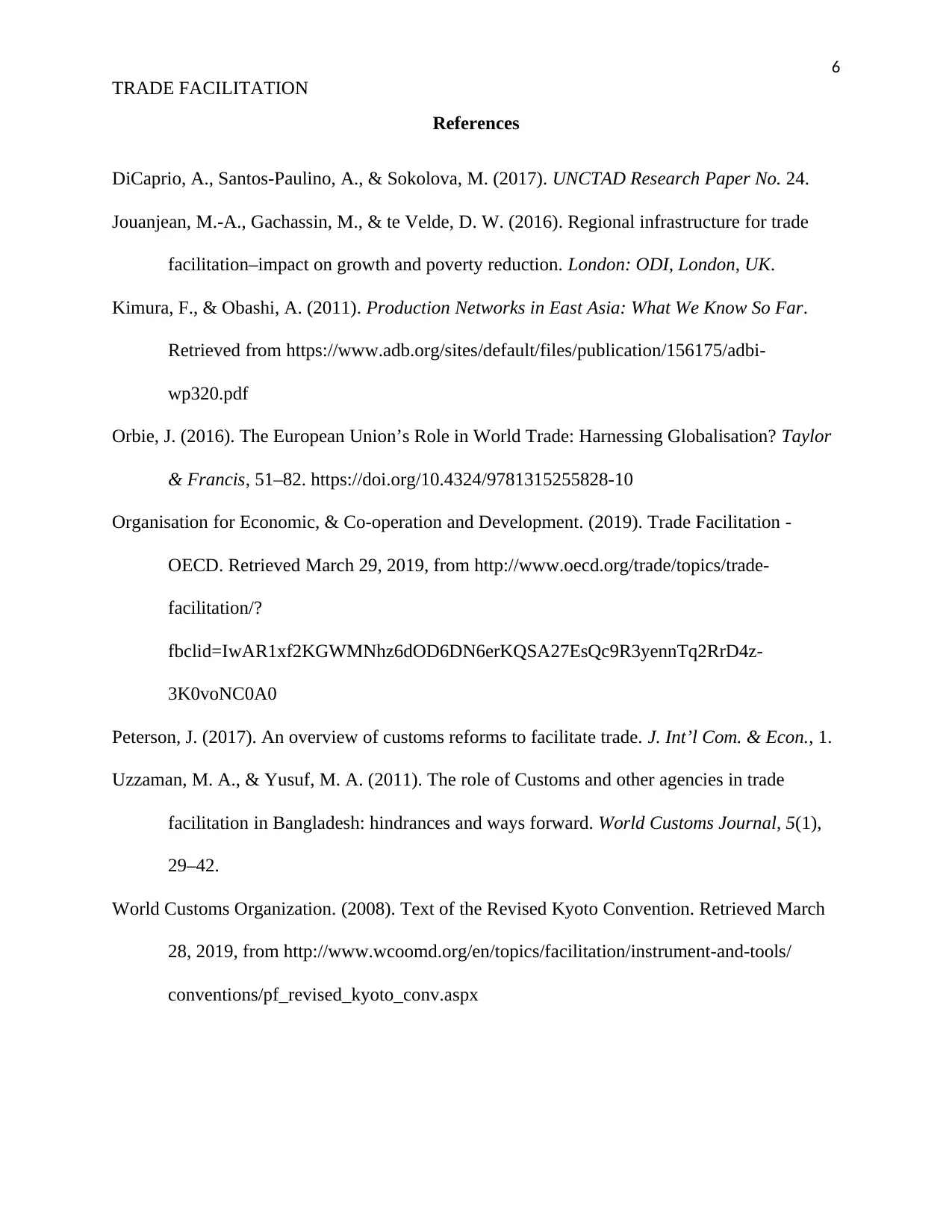
6
TRADE FACILITATION
References
DiCaprio, A., Santos-Paulino, A., & Sokolova, M. (2017). UNCTAD Research Paper No. 24.
Jouanjean, M.-A., Gachassin, M., & te Velde, D. W. (2016). Regional infrastructure for trade
facilitation–impact on growth and poverty reduction. London: ODI, London, UK.
Kimura, F., & Obashi, A. (2011). Production Networks in East Asia: What We Know So Far.
Retrieved from https://www.adb.org/sites/default/files/publication/156175/adbi-
wp320.pdf
Orbie, J. (2016). The European Union’s Role in World Trade: Harnessing Globalisation? Taylor
& Francis, 51–82. https://doi.org/10.4324/9781315255828-10
Organisation for Economic, & Co-operation and Development. (2019). Trade Facilitation -
OECD. Retrieved March 29, 2019, from http://www.oecd.org/trade/topics/trade-
facilitation/?
fbclid=IwAR1xf2KGWMNhz6dOD6DN6erKQSA27EsQc9R3yennTq2RrD4z-
3K0voNC0A0
Peterson, J. (2017). An overview of customs reforms to facilitate trade. J. Int’l Com. & Econ., 1.
Uzzaman, M. A., & Yusuf, M. A. (2011). The role of Customs and other agencies in trade
facilitation in Bangladesh: hindrances and ways forward. World Customs Journal, 5(1),
29–42.
World Customs Organization. (2008). Text of the Revised Kyoto Convention. Retrieved March
28, 2019, from http://www.wcoomd.org/en/topics/facilitation/instrument-and-tools/
conventions/pf_revised_kyoto_conv.aspx
TRADE FACILITATION
References
DiCaprio, A., Santos-Paulino, A., & Sokolova, M. (2017). UNCTAD Research Paper No. 24.
Jouanjean, M.-A., Gachassin, M., & te Velde, D. W. (2016). Regional infrastructure for trade
facilitation–impact on growth and poverty reduction. London: ODI, London, UK.
Kimura, F., & Obashi, A. (2011). Production Networks in East Asia: What We Know So Far.
Retrieved from https://www.adb.org/sites/default/files/publication/156175/adbi-
wp320.pdf
Orbie, J. (2016). The European Union’s Role in World Trade: Harnessing Globalisation? Taylor
& Francis, 51–82. https://doi.org/10.4324/9781315255828-10
Organisation for Economic, & Co-operation and Development. (2019). Trade Facilitation -
OECD. Retrieved March 29, 2019, from http://www.oecd.org/trade/topics/trade-
facilitation/?
fbclid=IwAR1xf2KGWMNhz6dOD6DN6erKQSA27EsQc9R3yennTq2RrD4z-
3K0voNC0A0
Peterson, J. (2017). An overview of customs reforms to facilitate trade. J. Int’l Com. & Econ., 1.
Uzzaman, M. A., & Yusuf, M. A. (2011). The role of Customs and other agencies in trade
facilitation in Bangladesh: hindrances and ways forward. World Customs Journal, 5(1),
29–42.
World Customs Organization. (2008). Text of the Revised Kyoto Convention. Retrieved March
28, 2019, from http://www.wcoomd.org/en/topics/facilitation/instrument-and-tools/
conventions/pf_revised_kyoto_conv.aspx
1 out of 7
Your All-in-One AI-Powered Toolkit for Academic Success.
+13062052269
info@desklib.com
Available 24*7 on WhatsApp / Email
![[object Object]](/_next/static/media/star-bottom.7253800d.svg)
Unlock your academic potential
Copyright © 2020–2025 A2Z Services. All Rights Reserved. Developed and managed by ZUCOL.